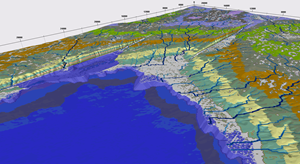Source-to-Sink Analysis of Rift Basin Tectonics and Sedimentation: Towards Improved Reservoir Prediction
Research on active and ancient fault zones and numerical simulations of rift basins suggest that fault growth, interaction and linkage are primary controls on the evolution of footwall topography, stream networks, hangingwall basin geometry and depositional systems.
Main content
The stratigraphic record of rift basins is the combined record, not only of fault growth, but also sea-level variation and climate change. Success in exploiting syn-rift reservoirs, is only as good as our understanding of how the various tectonic and surface process signals control depositional systems in time and space. If we can better understand this complex interplay of controls, we will reduce risk in exploration and provide more quantitative constraints on the geometry, continuity and heterogeneity of syn-rift reservoirs. At present, advances in understanding syn-rift sequences are largely divorced from quantifying the topographic and drainage evolution in rift settings, despite general acknowledgement that sediment supply is a fundamental control on location, volume and stacking patterns of reservoir sandbodies. Quantitative analysis, integrating an understanding of fault growth history with a source-to-sink analysis of drainage catchments and depositional systems, is required to move to the next level of understanding syn-rift basin fills. This source-to-sink view is needed to understand the complex interplay of controls on syn-rift depositional sequences and reservoirs and to rationalise this complexity to identify what is practical to use in day-to-day exploration workflows.
We apply novel numerical modelling that couples Discrete Element Numerical Modelling of rift basin evolution with Landscape Evolution models that include normal fault growth and deposition, to investigate relationships between drainage catchment development, sediment transport and deposition within rift basins. In addition to focusing on the coupled response of source areas and depositional systems to normal fault growth, other major controls on the drainage and stratigraphic evolution such as bedrock lithology, climate change and sea-level change are examined. The project is a 3 year project sponsored by Statoil.
Researchers working on this project:
Emma Finch
Simon Brocklehurst
Jonathan Smith (UoM)
